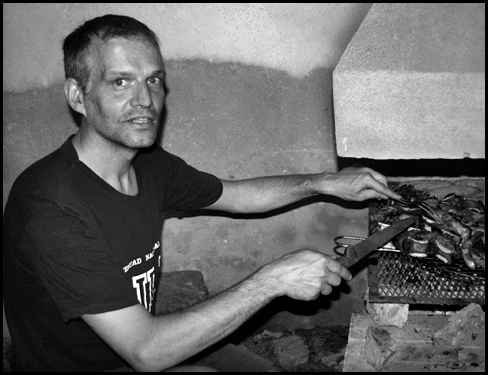Page de Pablo Jensen
 **************************************
**************************************
Toy models of social systems
Toy models are not very useful for understanding social reality, but they can help correcting our intuitive models.
For example, Schelling's segregation model (see below) shows that inferring racist individuals from segregated neighborhoods is not rigorous: the link between the micro level (the individual) and the macro level (urban segregation) is much more complex than a simple correspondence.
In a more recent simple model, we show that it is possible to observe multiple currencies at equilibrium, even in presence of increasing returns to adoption.
Or that MICROscopic causes can have MACROscopic consequences ( to be published in Phys Rev Lett)
Actually, the whole micro/macro divide is not very helpful for social systems, as we show here
.
Respectful extension of statistical physics tools to analyze some social systems
The intricate relations between the individual and collective levels are at the heart of many natural and social sciences. Different disciplines wonder how atoms combine to form solids, neurons give rise to consciousness or individuals shape societies. However, scientific fields assume distinct points of view for defining the ``normal'', or ``equilibrium'' aggregated state. Physics looks at the collective level, selecting the configurations that minimize the global free energy. In contrast, economic agents behave in a selfish way, and equilibrium is attained when no agent can increase its own satisfaction. Although similar at first sight, the two approaches lead to radically different outcomes.
In this paper published in PNAS (2009), we illustrate the differences between the collective and individual dynamics on an exactly solvable model, similar to Schelling's segregation model. The model considers individual agents which prefer a mixed environment, with dynamics that lead to segregated or mixed patterns at the global level. A ``tax'' parameter monitors continuously the agents' degree of altruism or cooperativity, i.e., their consideration of the global welfare. At high degrees of cooperativity, the system is in a mixed phase of maximal utility. As the altruism parameter is decreased, a phase transition occurs, leading to segregation. In this phase, the agents' utilities remain low, in spite of continuous efforts to maximize their satisfaction. This paradoxical result of Schelling's segregation model has generated an abundant litterature. Our analytical approach generalizes the free energy function used in physics to take into account the individual dynamics, introducing a "link" state function which is maximized in the stationary state. Therefore, our paper provides a quantitative, rigorous solution to Schelling's model, extending previous attempts to use physics' tools for such a task. Moreover, it can applied to any utility function, in contrast to previous attempts that were limited to specific cases.
The dynamics of epidemics propagation
Thanks to the DYNANETS european project, we have been working on the propagation dynamics of epidemics. A paper is on preparation with Andrea Apolloni.
 An EU FP7 project
An EU FP7 project
www.dynanets.org
On the emergence of an 'intention field' for socially cohesive agents
This paper sprung out of a one-day meeting between physicists and sociologists at Sciences- Po, Paris, on 24 May 2013, entitled ‘Le tout est-il plus ou moins que la somme de ses parties?’
Exploring the polycentric city with an agent-based model
We present an agent-based model grounded in the Alonso, Muth, Mills (AMM) framework, using microeconomic interactions between heterogeneous agents and able to reach the equilibrium in a dynamic way. This model is shown to reproduce the equilibrium of the AMM model. An illustration is given with two income groups. Two job centers at various distances from each other are introduced. Economic, social and environmental outcomes of these various polycentric spatial structures are studied. Then two-worker households whose partners may work in different job centers are introduced. Regarding welfare we find that polycentrism is desirable, as long as centers are not moved too far apart from each other. The environmental outcome is also positive for small values of this distance but this positive effect is mitigated by the fact that housing surfaces increase.
Exact solution of Nash equilibria of the Hotelling model in two dimensions
In collaboration with H Larralde (UNAM, Mexico) and Juliette Stehle (M1 student of physics at ENS Lyon), we calculated accurately, for the first time, the Nash equilibria for the Hotelling model in two dimensions work (article published in Regional Science and Urban Economics ). We also studied qualitatively why differentiation takes place only on one dimension.
**************************************
NB : Vous pouvez télécharger des articles de ce site à condition de
respecter les règles du copyright.
NB : Please respect the copyright rules when accessing full lenght
articles on this site.
Courriel: pablo.jensen at ens-lyon.fr
Téléphone: +33 4 26 23 38 01
 **************************************
**************************************
 An EU FP7 project
An EU FP7 project